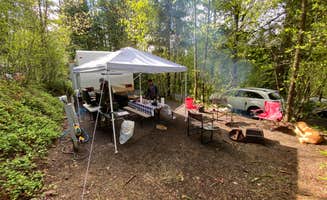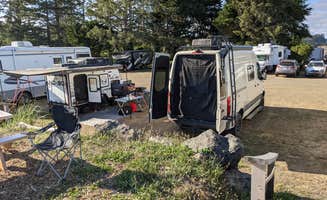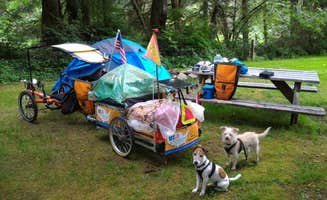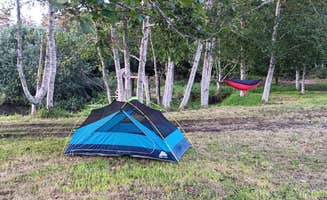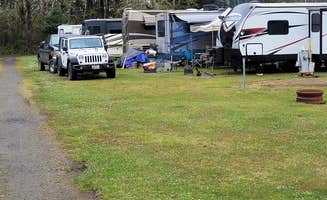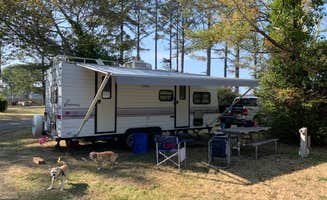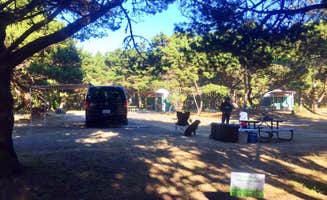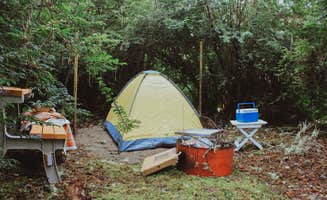Camping options near Raymond, Washington extend beyond coastal campgrounds to include forested state parks and dispersed sites in surrounding hills. The region sits at low elevation, generally between sea level and 500 feet, making most camping areas accessible year-round despite significant rainfall averaging 70-80 inches annually. Seasonal conditions impact the camping experience, with summer offering drier conditions while winter camping requires preparation for mud and wet tent sites.
What to do
Beach exploration at low tide: Campers staying at Grayland Beach State Park can take advantage of tidal flats for shell collecting. "Great location on an uncrowded beach. Simple, but great facilities. Clean and well organized. Lots of sand dollars," notes Dan N. about the beach activities.
Hiking through coastal forests: Several camping areas offer trails through varied terrain. At Lake Sylvia State Park Campground, visitors find "miles of trails" with some following old logging roads converted to bike trails. The park features "a large swimming and fishing lake" as the centerpiece for activities.
Historical sites exploration: The coast offers numerous historical attractions within driving distance from camp. At Fort Stevens State Park Campground, campers can explore military installations. "This is a great campground with a lot of sites. Visiting the Iredale shipwreck especially at sunset is beautiful. Also visiting the forts and cannons are fun," recommends Gail S.
Wildlife viewing: The area provides opportunities to see coastal and wetland species. Early mornings or evenings near water access points offer the best viewing times. Bruceport County Park sits "on cliff above Willapa Bay" with "a short trail to the beach to watch the sunsets and search for shells."
What campers like
Privacy between sites: Many campers appreciate well-spaced campsites that provide separation from neighbors. At Twin Harbors State Park Campground, John G. notes that "Very nice tent portion of the campground, short walk to the beach, beach is very long and uncrowded, although they allow driving on it." However, he adds that "RV spots with hookups are lined up next to each other, very little space between."
Access to uncrowded beaches: Less-visited beach areas allow campers to enjoy quieter coastal experiences. "We were one of the few tents there; most people are in their RVs. Going to sleep with the sound of the ocean at night was priceless," reports Geanna R. about Grayland Beach.
Clean facilities: Well-maintained bathrooms and showers matter to campers. At Grayland Beach, Leonard H. found "Good clean rest rooms and free showers. Shower was an acceptable warm temperature."
Cell service variability: Signal strength varies significantly throughout the region. At Bay Center-Willapa Bay KOA, Robert O. reports "We got a very good Verizion signal(4 bars) for our Hot spot and 2-3 bar signal for our AT&T hot spot." However, at other locations like Grayland Beach, campers note "Poor cell signal at the campground."
What you should know
Seasonal changes impact access: Campground availability varies throughout the year. Bay Center-Willapa Bay KOA operates only "Apr 3 to Nov 29" while state parks typically remain open year-round.
Primitive camping options exist: For those seeking more solitude, dispersed sites are available. At Road to Snag Lake, Ryan S. reports "There are several spots off the road around these radio tower stations and it is quite secluded. We didn't see any other person the whole time we were there."
Weather considerations: The coast experiences significant rain and fog, particularly in winter. One camper at Twin Harbors State Park described a February visit: "We had not counted on the thick fog that often blankets the coast that time of year and, arriving in the dark, set up camp."
Reservation requirements: Most established campgrounds require advance bookings. State parks often fill up months in advance for summer weekends, while some smaller county parks may have availability for last-minute trips. At popular locations, plan 3-6 months ahead for prime summer dates.
Tips for camping with families
Playground access: Several campgrounds offer dedicated play areas for children. Lake Sylvia State Park is described as "Amazing place to camp for families! Nice sites, clean restrooms, swimming, kayaking, a playground, and miles of trails!" by Ashley E.
Beach safety knowledge: Understand tidal patterns and supervise children near water. Some beaches have roped-off swimming areas during summer while others have strong currents. At Twin Harbors, one camper noted "There's a parking area at the head of the trail to the beach" making access more manageable with young children.
Wildlife viewing opportunities: Many campgrounds offer opportunities to spot local animals. At Ocean City State Park, a camper mentions "deer everywhere!" which can provide exciting moments for children to observe wildlife safely.
Insect preparation: Mosquitoes can be numerous in wooded areas, especially near lakes and in evening hours. Gail S. specifically advises visitors to Fort Stevens State Park to "Bring mosquito repellent!"
Tips from RVers
Hookup location challenges: Some campgrounds have inconveniently placed utilities. At Twin Harbors State Park, one RVer noted "We had to run to town because the water and power hookups are ridiculously far away from where they sit on anyone's trailer or RV."
Site size considerations: Research carefully before booking to ensure adequate space. At Ocean City State Park, an RVer found "Very hard to tell when looking at map or reservation site, what the site is really like. This campground had all types of sites, from dark and woodsy, to bright and sunny."
Road conditions for larger rigs: Access roads vary in quality throughout the region. For dispersed camping at Road to Snag Lake, a reviewer cautions "The road getting here is a bit rough with lots of washboard, steep grades and rocks," suggesting careful consideration for larger vehicles.


